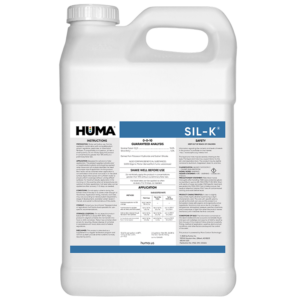D-FEND
Benefits of Use:
- Provides essential plant nutrients
- Nutrients plus natural oils and extracts improve plant tolerance of environmental stresses
- Tank-mixes with most chemical pesticides
- Delivers maximum performance with no negative environmental impact
- Can be used to carry any combination of Huma® nutrients
- Minimizes leaf burn or phytotoxicity associated with foliar nutrient sprays
Deficiency Symptoms—When to Apply:
- Plants weakened due to stress/disease
- Nutrients not being absorbed by plant
- Yellowing of leaves
- Early decay of plants
FAQs
Related Products
Related Case Studies

Huma® Fertilizer Program Improves Potato Yield by 5%, With 200% ROI
Background Huma® liquid fertilizer programs with Micro Carbon Technology® provide growers with efficient crop nutrients via foliar spray or irrigation at the exact time crops need them. Precision timing of efficient nutrition provides better crop yield and quality. Objective The focus of this study was to assess how the efficient Huma® nutritional products affect potato

Humic Products Increase Soybean Yield In Iowa
Background Scientific research shows humic and fulvic acids can have a biostimulant effect on plant root growth and mass, nutrient availability and uptake, and crop yield and quality. Objective The objective of this study was to compare and contrast the immediate effects that three types of humic products from Huma®, Inc., have on soybean yield.

PROUD 3 Fungicide Replacement
Background Huma® fungicide programs with Micro Carbon Technology® provide growers with effective options that can replace synthetic fungicides with a more sustainable and environmentally friendly approach, while providing excellent control and improving crop health, yield and quality. Objective The focus of this study was to assess if 2 of Huma’s products CROP-GARD® (Growth Manager) and
Related Blog Posts

This Week in Ag #32
Everyone remembers where they were on September 11, 2001. One of my most vivid memories was the week after. I was farming with my dad at the time. He had just started cutting soybeans in a field owned by my wife’s family, situated next to Interstate 74 in western Illinois. I was driving to the

BHN’s Fertilgold® Organics Earns OMRI-Listing for 21 Products
Fertilgold® Organics, a brand of organic fertilizer products from Bio Huma Netics, Inc. (BHN) headquartered in Gilbert, Ariz., has achieved Organic Materials Review Institute (OMRI) listing for 21 initial products. Of these, 13 OMRI-listed liquid crop nutrition products are based on the company’s proprietary nutrient carrier, Micro Carbon Technology®, which carries nutrients to plants more

Our Humic Advantage
Humic substances, among the most wondrous products of nature, are the recycled essential residues of life. Plants harvest the sun’s energy and create life from that energy plus the carbon and oxygen they pull out of the air and the minerals they pull out of the soil. When plants die, all of their components are










